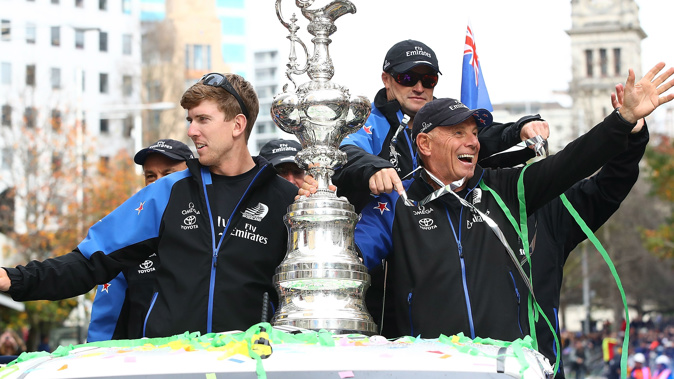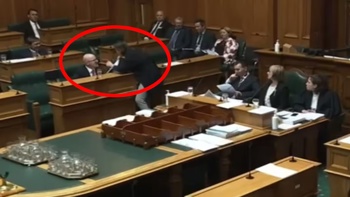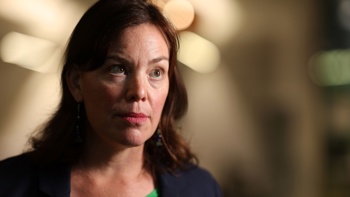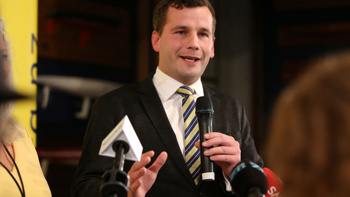
Only days after returning from the TPP trade talks in Asia, Trade Minister David Parker has been given the task of hammering out an agreement for the America's Cup bases in Auckland.
Parker, who is also Minister of Economic Development and Environment, with responsibility for the America's Cup, has the job of striking a deal that meets Team New Zealand's needs and is acceptable to the Government and Auckland Council.
There's a wide range of issues to be resolved, not least the effect of the options on the environment, planning issues, cost and the practical requirements of Team New Zealand.
Also hanging over an agreement to host the event in Auckland, is Team New Zealand reserving the right to hold the event in Italy, or even Tauranga, if suitable infrastructure is not made available.
During a four-hour visit to the proposed sites on Sunday and two meetings with Mayor Phil Goff and Team New Zealand boss Grant Dalton, among others, Parker made it known that environmental issues are a sticking point.
It was environmental issues that led Prime Minister Jacinda Ardern to speak at public protests against further reclamation of the Waitemata Harbour for port use in 2015.
"She is very supportive of what I am doing here," Parker said.
Sunday's appearance by Parker, which drew all the major players to the waterfront, has acted as a circuit-breaker to what was seen as a stand-off between Goff and Dalton.
The parties' visions for the event - and the future of Auckland waterfront - differ greatly, with Goff favouring the cheaper $137 million option that disperses the bases across three city wharves, while Team New Zealand's preference is to centralise the bases on an extension to Halsey Wharf covering 3ha of water space at a cost of $190m.
Parker said his talks drew constructive suggestions from all the parties, which included government and council officials and community groups Stop Stealing Our Harbour and Urban Auckland.
"Team New Zealand provided us with information regarding practicalities. They are at the point of finalising design of the regatta yachts and that has an effect on the practicality of various sites.
"It requires all three corners of the triangle to reach agreement. We haven't struck a deal but we are getting closer," Parker said.
The minister said he does not want to sound dictatorial, but expects to see some revised plans within the next week, saying the effective date for a final decision is early January when work on a resource consent needs to start.
By calling for some revised plans, Parker has made the council's timetable to make a decision on Thursday more difficult.
Instead of making a final call from a list of five options, Goff says a "decision of sorts" will be reached with room for flexibility as plans progress. Judging from Parker's comments, the Government is in no hurry to rush a decision.
To date, Team New Zealand have kept largely quiet but made it known they favour the option of extending Halsey Wharf 220m into the harbour as a location for centralising all events facilities for the benefits of the teams, media, local supporters and international visitors.
When it became apparent Goff and others were pushing the option of four bases on Halsey Wharf, three on Wynyard Wharf and one on Hobson Wharf, sources said Team New Zealand was becoming alarmed at the prospect of a "bad decision" being made.
"The Halsey extension is the legacy option. The dispersed options would be there for the cup and would then disappear. Halsey Wharf would be there for visitors, for superyachts, for triathlon events and all sorts of water-based events," a source said.
Goff's arguments for favouring the dispersed wharf option is it is less intrusive than a 220m extension of Halsey Wharf into the harbour, $41m cheaper to build and would be eight months quicker to construct.
The cost is weighing heavily of Goff, who wants to see a big contribution from Government. The $190 million cost of extending Halsey Wharf is the equivalent of the Government's contribution to upgrading Eden Park for the 2011 Rugby World Cup and almost eight times the $26m cost of the National Aquatic Centre on the North Shore.
Funding for the cup has to be included in the council's new 10-year budget where there is no spare cash and facilities like the Auckland Art Gallery, which is considering closing its doors one or two days a week, are crying out for more money.
After assessing options against three criteria - ability to meet a timeframe for completion by late 2019, meet the requirements of Team New Zealand and deliver a legacy - a working group produced a shortlist of five options, which has came down to two most likely sites. These are the Halsey Wharf extension and the dispersed option across Halsey, Wynyard and Hobson wharves.
Extending Captain Cook Wharf, which is currently used to store vehicles by Ports of Auckland, east and west has been ruled out as impractical timewise and lacking shelter for yachts. A third option to disperse the bases between Halsey, Hobson and an extension to Westhaven Marina would create a big distance between the bases and fallen out of a favour.
Since the weekend, officials have been asked to look at a third option of dispersing the bases on Wynyard Wharf and possibly Halsey Wharf.
The three options:

Extending Halsey Wharf
This would require pushing the wharf 220m into the harbour space between Wynyard and Princes Wharves covering 3ha in a newly configured sheltered water space. The option includes an extension to Hobson Wharf for one berth and seven berths on Halsey Wharf, three of which would be single-boat berths.
Public access to the wharf will be around the perimeter where the public will have limited views into the base syndicates but able to see super yachts and support vessels moored on the western side.
Pros
This would centralise up to eight syndicate bases in one location as favoured by Team New Zealand and provide a legacy for marine events like the Volvo Ocean Race, an annual waka festival and triathlons, although there are few details.
Cons
Vehemently opposed by groups like Stop Stealing Our Harbour and Urban Auckland. Architect David Mitchell says the city already has a cup village all the way from the ferry wharves to the Westhaven.
The option goes against the council's waterfront masterplan to protect views from the city to a new park at the end of Wynyard Point.
Urban planner Joel Cayford said on past practice, the wharf extension could be sold for apartments.
The most expensive option.
Disperse bases between Halsey, Wynyard and Hobson wharves
Pros
This is the cheapest option at $137m, although all the costings are "very indicative". It involves a 50m extension to the northern end of Halsey Wharf to accommodate four bases. There would be one base on Hobson Wharf and three bases at the base of Wynyard Wharf to create a "cluster" around North Wharf and Viaduct Harbour. This is Goff's favoured option.
Cons
It involves some expansion into the harbour space. Team New Zealand believe it would be there for the cup and then disappear, leaving no legacy for the city.
Dispersed option around Wynyard Quarter
Pros
This is the revised plan Parker called for on Sunday - taking a second look at a proposal first put forward by Urban Auckland to utilise a site, known as Lot 18, south of Silo Park and land on the west and eastern sides of Wynyard Wharf. Halsey Wharf could also be used.
This option would require the least amount of reclamation.
Costs are still being worked on.
Cons
The bases would be more widely dispersed than say option 2. Does not have strong backing from the main stakeholders.
Take your Radio, Podcasts and Music with you









